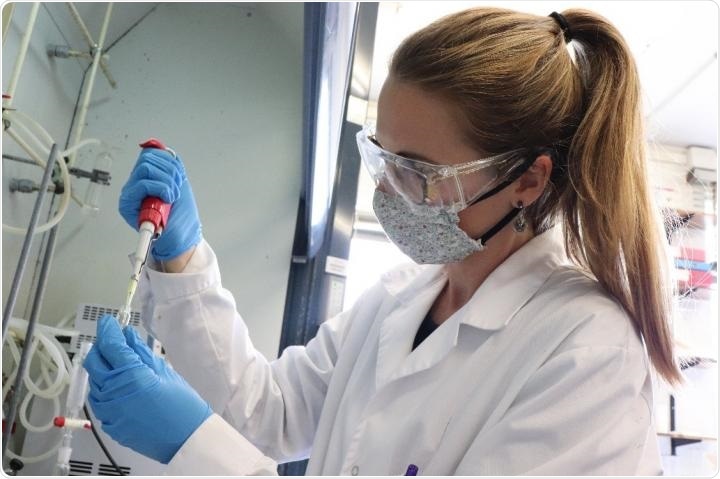A new study was conducted by researchers from the Spanish National Research Council’s Institute for Advanced Chemistry of Catalonia (IQAC-CSIC) in association with Stony Brook University (USA). The study has proposed a new method for developing novel drugs based on the suppression of tyrosine kinase enzymes—molecules that stimulate and trigger a number of cellular processes. The findings have been published in the Chemistry-A European Journal.

Lucía Tapia, author of this study, at the Institute for Advanced Chemistry of Catalonia. Image Credit: Alejandro Rodríguez/IQAC-CSIC.
The novel technique is based on the regulation of the tyrosine kinase signaling cascade and may lead to the development of enhanced and more selective instruments for diagnosis, research, and treatment of certain diseases.
Tyrosine kinases are a group of enzymes that are crucial for the body’s inter-cellular interaction, which activates biochemical processes that are necessary for life.
The dysfunction of these enzymes is related to serious diseases such as diabetes, some neurological disorders and many types of cancer.”
Ignacio Alfonso, Researcher, IQAC-CSIC
They activate different signaling pathways
Cell signaling is the mechanism through which cells interact with one another. Within the cell, there are specific proteins or several types of receptors that detect the proteins produced by the body and cause the cell to respond to them. Tyrosine kinases are one of the most significant molecules.
Cells receive signals from the environment when a molecule (a hormone, for example) binds to one of these receptors. The receptor recognizes the molecule and triggers a series of chemical reactions.”
Ignacio Alfonso, Researcher, IQAC-CSIC
This enables cells to regulate major activities of the body, like the multiplication or destruction of cells. Every process has its own individual signaling pathways. Once the first molecule in the signaling route receives the signal, another molecule is stimulated, followed by another and another, and so on throughout the signaling cascade, until the cellular function is met.
“The abnormal activation of signaling pathways can lead to diseases, such as cancer,” added the researcher.
Kinases are a group of molecules that activate several distinct signaling pathways, which means that they too are involved in all of these activities.
When you want to avoid any of these processes, a research strategy is to inhibit kinases, blocking them with synthetic molecules. But this strategy is not very selective, since other important pathways may be inhibiting.”
Ignacio Alfonso, Researcher, IQAC-CSIC
As a matter of fact, the similarity of kinases and their functional flexibility (the same kinase acts on multiple molecules and participates in diverse processes) has made it challenging to create specialized inhibitors to dissect different functions in fundamental research or modulate pathological conditions.
Target: the place where kinases act
And it is exactly here where the new study suggests an alternative approach: that is, instead of inhibiting the kinases, the molecules on which the kinases act can be covered and blocked. The instrument for this would be artificial synthetic receptors or synthetic molecules that would protect the site of action of the kinases.
“Our group has designed molecules that interact with the substrates of the kinase, and not with the kinase. We have prepared artificial molecular 'cages', made up of pseudopeptides, that are able to modulate the activity of these enzymes,” clarified the researcher.
“This complementary approach paves the way for selective modulation of an individual kinase-stimulated signaling pathway, without interfering with other functions of the kinase. This technology would enable investigators to dissect the contributions of specific signaling pathways in cellular function,” explained Todd Miller from Stony Brook University.
Although this is a proof-of-concept study, the findings may lead to more specific inhibitors/modulators of these kinases that could be utilized as research tools to fully comprehend this complicated communication network.
“This approach generates basic knowledge, which could be essential to better understand key biological functions and the origin of many diseases,” concluded Dr. Alfonso.
Source:
Journal reference:
Tapia, L., et al. (2021) Modulation of Src Kinase Activity by Selective Substrate Recognition with Pseudopeptidic Cages. Chemistry - A European Journal. doi.org/10.1002/chem.202100990.